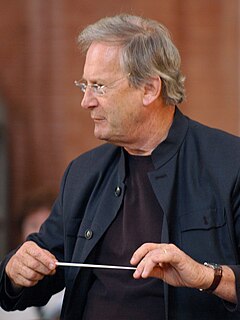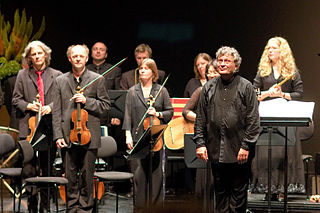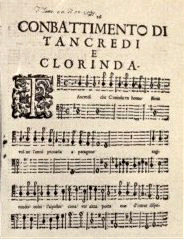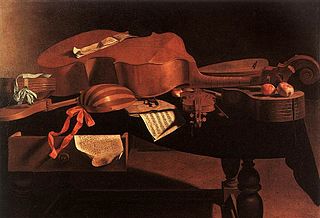Related Research Articles

Claudio Giovanni Antonio Monteverdi was an Italian composer, string player, choirmaster, and priest. A composer of both secular and sacred music, and a pioneer in the development of opera, he is considered a crucial transitional figure between the Renaissance and Baroque periods of music history.
A scherzo, in western classical music, is a short composition – sometimes a movement from a larger work such as a symphony or a sonata. The precise definition has varied over the years, but scherzo often refers to a movement that replaces the minuet as the third movement in a four-movement work, such as a symphony, sonata, or string quartet. The term can also refer to a fast-moving humorous composition that may or may not be part of a larger work.

Sir John Eliot Gardiner is an English conductor, particularly known for his performances of the works of Johann Sebastian Bach.

A madrigal is a secular vocal music composition of the Renaissance and early Baroque (1600–1750) eras. The polyphonic madrigal is unaccompanied, and the number of voices varies from two to eight, but usually features three to six voices, whilst the metre of the madrigal varies between two or three tercets, followed by one or two couplets. Unlike the verse-repeating strophic forms sung to the same music, most madrigals are through-composed, featuring different music for each stanza of lyrics, whereby the composer expresses the emotions contained in each line and in single words of the poem being sung.

Salamone Rossi or Salomone Rossi was an Italian Jewish violinist and composer. He was a transitional figure between the late Italian Renaissance period and early Baroque.

René Jacobs is a Belgian musician. He came to fame as a countertenor, but later in his career he became known as a conductor of baroque and classical opera.

Dmitri Shostakovich’s Symphony No. 7 in C major, Op. 60, nicknamed the Leningrad, was begun in Leningrad, completed in the city of Samara in December 1941, and premiered in that city on March 5, 1942. At first dedicated to Lenin, it was eventually submitted in honor of the besieged city of Leningrad, where it was first played under dire circumstances on August 9, 1942, during the siege by German and Finnish forces. The Leningrad soon became popular in both the Soviet Union and the West as a symbol of resistance to fascism and totalitarianism, thanks in part to the composer's microfilming of the score in Samara and its clandestine delivery, via Tehran and Cairo, to New York, where Arturo Toscanini led a broadcast performance and Time magazine placed Shostakovich on its cover. That popularity faded somewhat after 1945, but the work is still regarded as a major musical testament to the 27 million Soviet people who lost their lives in World War II, and it is often played at Leningrad Cemetery, where half a million victims of the 900-day Siege of Leningrad are buried.
The Gramophone Classical Music Awards, launched in 1977, are one of the most significant honours bestowed on recordings in the classical record industry. They are often viewed as equivalent to or surpassing the American Grammy award, and referred to as the Oscars for classical music. They are widely regarded as the most influential and prestigious classical music awards in the world. According to Matthew Owen, national sales manager for Harmonia Mundi USA, "ultimately it is the classical award, especially worldwide."

Il combattimento di Tancredi e Clorinda, SV 153, is an operatic scena for three voices by Claudio Monteverdi. The libretto is drawn from Torquato Tasso's La Gerusalemme Liberata. It was first performed in Venice in 1624, and printed in 1638 in Monteverdi's eighth book of madrigals. Monteverdi used musical features here for the first time to enhance the dramatic depiction of a battle in stile concitato, such as pizzicato and tremolo.

The concerto delle donne was a group of professional female singers in the late Italian Renaissance, primarily in the court of Ferrara, Italy. Renowned for their technical and artistic virtuosity, the ensemble was founded by Alfonso II, Duke of Ferrara, in 1580 and was active until the court was dissolved in 1597. Giacomo Vincenti, a music publisher, praised the women as "virtuose giovani", echoing the sentiments of contemporaneous diarists and commentators.

Les Arts Florissants is a Baroque musical ensemble in residence at the Théâtre de Caen in Caen, France. The organization was founded by conductor William Christie in 1979. The ensemble derives its name from the 1685 opera Les Arts florissants by Marc-Antoine Charpentier. The organization consists of a chamber orchestra of period instruments and a small vocal ensemble. Current notable members include soprano Danielle de Niese and tenor Paul Agnew, who has served as assistant conductor since 2007. Jonathan Cohen is also on the conducting staff; Christie remains the organization's Artistic Director.
The modern state of Italy did not come into being until 1861, though the roots of music on the Italian Peninsula can be traced back to the music of ancient Rome. However, the underpinnings of much modern Italian music come from the Middle Ages.
Julianne Baird is an American soprano best known for her singing in Baroque works, in both opera and sacred music. She has nearly 100 recordings to her credit and is a well-traveled recitalist and soloist with major symphony orchestras. She is also a noted teacher of voice.
The Philip Jones Brass Ensemble, founded in 1951 by trumpeter Philip Jones, was one of the first modern classical brass ensembles to be formed. The group played either as a quintet or as a ten-piece, for larger halls. It toured and recorded extensively, and numerous arrangements were commissioned, many of which were bequeathed on Jones' death to the library of the Royal Northern College of Music.
Denis William Stevens CBE was a British musicologist specialising in early music, conductor, professor of music and radio producer.
Bartolo Musil is an Austrian baritone singer and composer, born in Klagenfurt.
Hermann Matthias Werrecore was a Flemish composer in Italy. He was maestro di cappella of Milan Cathedral from 1522 to 1550 where he was in charge of eleven adult singers and seven choirboys.
Pascal Bertin is a French countertenor.
Profeti della Quinta is a male vocal ensemble, specializing in the music of the Renaissance and Baroque periods. Founded in the Galilee region of Israel by Elam Rotem, the ensemble is currently based in Basel, Switzerland, where its members undertook advanced studies at the Schola Cantorum Basiliensis. The core of the ensemble includes countertenor, tenor and bass singers, who perform either a-cappella or together with period instruments such as theorbo and harpsichord.
References
- ↑ Harvard dictionary of music - Page 86 Willi Apel - 1969 "Battaglia [It.]. Name for a composition in which the fanfares, cries, drum rolls, and general commotion of a battle [It. battaglia] are imitated. This was a favorite subject of *program music from the 16th through the 18th centuries. Late 14th-century ..."
- ↑ Robert Cowley, Geoffrey Parker - The Reader's Companion to Military History - Page 390 2001 "In the first movement of his Seventh (Leningrad) Symphony (1941), Dmitri Shostakovich's (1906-1975) musical portrayal of the German invasion of the Soviet Union is obvious, his disclaimer not to have written battle music notwithstanding."